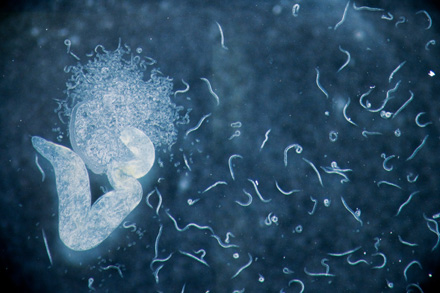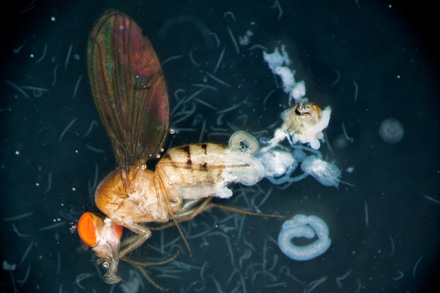Navigation
New Way to Conquer Disease-Causing Nematodes in Flies has Implications for Human Diseases
It has been a basic principle of evolution for more than a century that plants and animals can adapt genetically in ways that help them better survive and reproduce. Now, in a paper published in the journal Science, University of Rochester biologist John Jaenike and colleagues document a clear example of a new mechanism for evolution.
University of Rochester Biologist Documents a Novel Form of Adaptation through Natural Selection in the Journal 'Science'
 |
| Microscope image of parasitic nematode and its offspring dissected from drosophila fly by University of Rochester biologist John Jaenike June 21, 2010. Jaenike finds that nematodes have a more difficult time growing and developing in black flies that are infected with a type of bacteria called Spiroplasma. Being infected with Spiroplasma is advantageous for the black flies if the nematodes reduce the survival or reproduction of the flies, and this, in turn, encourages the natural spread of Spiroplasma. "The protection of an insect from a potent nematode parasite by a bacterial infection is of potential importance in both medicine and agriculture," says George Gilchrist, a program director at the National Science Foundation. "This study adds a new page to the catalogue of interactions between animals and bacteria." Credit: J. Adam Fenster/University of Rochester |
It has been a basic principle of evolution for more than a century that plants and animals can adapt genetically in ways that help them better survive and reproduce.
Now, in a paper published in the journal Science, University of Rochester biologist John Jaenike and colleagues document a clear example of a new mechanism for evolution. In previous well documented cases of evolution, traits that increase an animal's ability to survive and reproduce are conferred by favorable genes, which the animal passes on to its offspring. Jaenike's team has chronicled a striking example of a bacteria infecting an animal, giving the animal a reproductive advantage, and being passed from mother to children. This symbiotic relationship between host animal and bacteria gives the host animal a readymade defense against a hazard in its environment and thus has spread through the population by natural selection, the way a favorable gene would.
Jaenike provides the first substantial report of this effect in the wild in his paper "Adaptation via Symbiosis: Recent Spread of a Drosophila Defensive Symbiont," but he says it may be a common phenomenon that has been happening undetected in many different organisms for ages.
See the video with John Jaenike at the end of this article.
Aside from shedding light on an important evolutionary mechanism, his findings could aid in developing methods that use defensive bacteria to stave off diseases in humans.
 |
| A dissected Drosophila fly, parasitized by a nematode, is shown. Nematodes invade female flies when they are young by burrowing through their skin and prevent them from producing eggs once they mature. However, when a female fly is also infected with a bacteria species called Spiroplasma, the nematodes grow poorly and no longer sterilize the flies. Credit: J. Adam Fenster/University of Rochester |
Jaenike studied a species of fly, Drosophila neotestacea, which is rendered sterile by a parasitic worm called a nematode, one of the most abundant, diverse, and destructive parasites of plants and animals in the world. Nematodes invade female flies when they are young by burrowing through their skin and prevent them from producing eggs once they mature. However, when a female fly is also infected with a bacteria species called Spiroplasma, the nematodes grow poorly and no longer sterilize the flies, Jaenike found.
He also discovered that, as a result of the Spiroplasma's beneficial impact, the bacteria have been spreading across North America and rapidly increasing in frequency in flies as they are passed from mother to offspring. Testing preserved flies from the early 1980s, Jaenike found that the helpful bacteria were present in only about 10% of flies in the eastern United States. By 2008, the frequency of Spiroplasma infection had jumped to about 80%.
"These flies were really getting clobbered by nematodes in the 1980s, and it's just remarkable to see how much better they are doing today. The spread of Spiroplasma makes me wonder how much rapid evolutionary action is going on beneath the surface of everything we see out there," Jaenike said.
He reasoned that the substantial increase in Spiroplasma infection was an evolutionary response to the recent colonization of North America by nematodes. As the nematodes invaded the continent, the bacteria proved to be a convenient and potent defense against the nematodes' sterilizing effect. Now, the majority of flies in eastern North America carry the bacteria, and the bacterial infection appears to be spreading west. Without any mutation in their own genes, the flies have rapidly developed a defense against an extremely harmful parasite simply by co-opting another organism and passing it on from generation to generation.
"This is a beautiful case showing that the main reason these Spiroplasma are present in these flies is for their defensive role," said Nancy Moran, the Fleming Professor of Ecology and Evolutionary Biology at Yale University. Moran studies the role of defensive symbionts in aphids. "These heritable symbionts are a way for an animal host to acquire a new defense very quickly. One way to get a truly novel defense is to get a whole organism rather than mutating your own genes that aren't that diverse to begin with."
Jaenike's work could also have implications for disease control. Nematodes carry and transmit severe human diseases, including river blindness and elephantiasis. By uncovering the first evidence of a natural, bacterial defense against nematodes, Jaenike's work could pave the way for novel methods of nematode control. He plans to investigate that prospect further.
Jaenike's coauthors on the paper are Robert Unckless and Lisa Boelio from the University of Rochester, and Steve Perlman and Sarah Cockburn from the University of Victoria in British Columbia. The work was funded by the National Science Foundation.
This news was provided by the University of Rochester .
John Jaenike and colleagues document a clear example of a new mechanism for evolution: adaptation via symbiosis. Aside from shedding light on an important evolutionary mechanism, his findings could aid in developing methods that use defensive bacteria to stave off diseases in humans.
Search
Latest articles
Agriculture
- World Water Week: Healthy ecosystems essential to human health: from coronavirus to malnutrition Online session Wednesday 24 August 17:00-18:20
- World Water Week: Healthy ecosystems essential to human health: from coronavirus to malnutrition Online session Wednesday 24 August 17:00-18:20
Air Pollution
- "Water and Sanitation-Related Diseases and the Changing Environment: Challenges, Interventions, and Preventive Measures" Volume 2 Is Now Available
- Global Innovation Exchange Co-Created by Horizon International, USAID, Bill and Melinda Gates Foundation and Others
Biodiversity
- It is time for international mobilization against climate change
- World Water Week: Healthy ecosystems essential to human health: from coronavirus to malnutrition Online session Wednesday 24 August 17:00-18:20
Desertification
- World Water Week: Healthy ecosystems essential to human health: from coronavirus to malnutrition Online session Wednesday 24 August 17:00-18:20
- UN Food Systems Summit Receives Over 1,200 Ideas to Help Meet Sustainable Development Goals
Endangered Species
- Mangrove Action Project Collaborates to Restore and Preserve Mangrove Ecosystems
- Coral Research in Palau offers a “Glimmer of Hope”
Energy
- Global Innovation Exchange Co-Created by Horizon International, USAID, Bill and Melinda Gates Foundation and Others
- Wildlife Preservation in Southeast Nova Scotia
Exhibits
- Global Innovation Exchange Co-Created by Horizon International, USAID, Bill and Melinda Gates Foundation and Others
- Coral Reefs
Forests
- NASA Satellites Reveal Major Shifts in Global Freshwater Updated June 2020
- Global Innovation Exchange Co-Created by Horizon International, USAID, Bill and Melinda Gates Foundation and Others
Global Climate Change
- It is time for international mobilization against climate change
- It is time for international mobilization against climate change
Global Health
- World Water Week: Healthy ecosystems essential to human health: from coronavirus to malnutrition Online session Wednesday 24 August 17:00-18:20
- More than 400 schoolgirls, family and teachers rescued from Afghanistan by small coalition
Industry
- "Water and Sanitation-Related Diseases and the Changing Environment: Challenges, Interventions, and Preventive Measures" Volume 2 Is Now Available
- Global Innovation Exchange Co-Created by Horizon International, USAID, Bill and Melinda Gates Foundation and Others
Natural Disaster Relief
- STOP ATTACKS ON HEALTH CARE IN UKRAINE
- Global Innovation Exchange Co-Created by Horizon International, USAID, Bill and Melinda Gates Foundation and Others
News and Special Reports
- World Water Week: Healthy ecosystems essential to human health: from coronavirus to malnutrition Online session Wednesday 24 August 17:00-18:20
- STOP ATTACKS ON HEALTH CARE IN UKRAINE
Oceans, Coral Reefs
- World Water Week: Healthy ecosystems essential to human health: from coronavirus to malnutrition Online session Wednesday 24 August 17:00-18:20
- Mangrove Action Project Collaborates to Restore and Preserve Mangrove Ecosystems
Pollution
- Zakaria Ouedraogo of Burkina Faso Produces Film “Nzoue Fiyen: Water Not Drinkable”
- "Water and Sanitation-Related Diseases and the Changing Environment: Challenges, Interventions, and Preventive Measures" Volume 2 Is Now Available
Population
- "Water and Sanitation-Related Diseases and the Changing Environment: Challenges, Interventions, and Preventive Measures" Volume 2 Is Now Available
- "Water and Sanitation-Related Diseases and the Changing Environment: Challenges, Interventions, and Preventive Measures" Volume 2 Is Now Available
Public Health
- Honouring the visionary behind India’s sanitation revolution
- Honouring the visionary behind India’s sanitation revolution
Rivers
- World Water Week: Healthy ecosystems essential to human health: from coronavirus to malnutrition Online session Wednesday 24 August 17:00-18:20
- Mangrove Action Project Collaborates to Restore and Preserve Mangrove Ecosystems
Sanitation
- Honouring the visionary behind India’s sanitation revolution
- Honouring the visionary behind India’s sanitation revolution
Toxic Chemicals
- "Water and Sanitation-Related Diseases and the Changing Environment: Challenges, Interventions, and Preventive Measures" Volume 2 Is Now Available
- Actions to Prevent Polluted Drinking Water in the United States
Transportation
- "Water and Sanitation-Related Diseases and the Changing Environment: Challenges, Interventions, and Preventive Measures" Volume 2 Is Now Available
- Urbanization Provides Opportunities for Transition to a Green Economy, Says New Report
Waste Management
- Honouring the visionary behind India’s sanitation revolution
- Honouring the visionary behind India’s sanitation revolution
Water
- Honouring the visionary behind India’s sanitation revolution
- Honouring the visionary behind India’s sanitation revolution
Water and Sanitation
- Honouring the visionary behind India’s sanitation revolution
- Honouring the visionary behind India’s sanitation revolution

